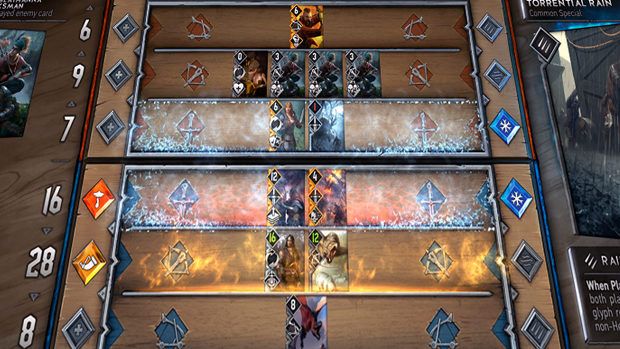Gwent finally entered open beta earlier this week, attracting a large number of newcomers to try out the free-to-play Witcher-themed collectible card game.
There is excitement in experiencing the lore-enriched fantasy world through another perspective. However, it is important that players first familiarize themselves with the basics of the game before throwing down cards at will.
The following Gwent guide runs through the important aspects of cards, their different groups and rarities, how they relate to factions, and other mechanics that must be understood before building decks.
Card Groups
Every card in Gwent falls into one of the following three groups: Bronze, Silver, and Gold. The different designations come with limitations where a single deck can only be comprised of unlimited Bronze, six Silver, and four Gold cards.
These have nothing to do with rarity, which will be explained afterwards. The groups can be determined through the colored border of every card.
Card Rarities
Every card in Gwent falls into one of the following four rarities: Common (White), Rare (Blue), Epic (Purple) and Legendary (Orange). The rarities can be determined through a tiny colored square in the bottom-right corner of every card.

Card Factions
Every card in Gwent falls into one of the following six factions: Neutral (Brown), Monsters (Red), Nilfgaardian Empire (Black), Northern Realms (Blue), Scoia’tael (Green), and Skellige (Purple).
Besides Neutral, the rest of the five factions feature three different Leaders; each offering various benefits and a powerful ability that can turn the tide of battle. The factions can be determined through the cloth banner draped on the left side of every card.
Card Positioning
Most cards in Gwent fall into one of the following three positions: Melee (Front), Ranged (Middle), and Siege (Back). However, there are also hybrid cards that can be placed in multiple positions. Agile cards can be played in any row; Loyal cards can be played only on the player’s side of the board while Disloyal cards are played on the opponent’s side. In addition, there are cards that are both Loyal and Disloyal, meaning that they can be played on any part of the board.
To understand the concept, imagine the playing board of the game as a battlefield. Different cards are designed to be placed in different positions (rows) against opponents. In addition, the game features Event cards that are spells and do not occupy the board.
The positions can be determined through an icon on the top-left side of every card: Melee (Sword), Ranged (Bow), Siege (Trebuchet), Agile (Circular Arrows), and Disloyal (Red Eye).

Card Icons
Gwent used to feature a number of different icons but the open beta has removed all of them, except for one. The Hourglass icon is found on the top-left corner of cards that boast special effects. It determines the number of turns required before the effect is triggered.
Card Types
There are over thirty different types of keywords/tags that cards can have in Gwent. Each determines behavior; what effects get triggered on the battlefield and how. It is important to understand how these core mechanics work since they work in tandem to other cards in combinations.
The following are just a few of the card types in the game. A more detailed list can be browsed through here.
- Ambush: Play face down and only reveal when certain conditions are met
- Banish: Remove the card from the game
- Bond: Trigger this ability each time another copy of this unit is played on the same side
- Brave: Trigger this ability if your opponent is winning the current round
- Deathwish: Trigger this ability when the card is moved to the Graveyard
- Deploy: Trigger this ability when the card is played on the field
- Destroy: Move the card to the Graveyard
- Resilience: The unit stays on the battlefield for the next round
- Resurrect: Returns a card from the Graveyard back into play

Card Kegs
A single keg contains five cards, one of which is guaranteed to be Rare or better. The first four are randomly pulled, leaving the player to pick out one from three given cards. This is an excellent design compared to other popular collectible card games like Hearthstone. Instead of forcing the player to take the fifth card, they have the freedom of choice to select their own Rare, or better, card. This eliminates duplicates or cards that are not needed.
Kegs can be earned as a leveling reward or purchased directly from the store with Ore or real-world money.
Currencies
There are three different currencies in Gwent: Ore, Scraps, and Meteorite Powder. They are used to not only purchase and craft new cards, but also upgrade current ones.
Ore is the primary in-game currency, which is earned by simply playing the game. A random amount can be gained through leveling, ranked games, daily rewards, and a good gesture from an opponent. It is spent in the store to purchase card kegs, where a single keg costs 100 Ore.
Scraps are used to craft new cards, with players having the option of choosing between normal and premium variants. The latter acts exactly as the normal ones, but they feature a unique animated design and come with an appropriate voice-over. Scraps are earned similar to Ore.
- 1 Common Card: 30 Scraps (Normal) or 200 Scraps (Premium)
- 1 Rare Card: 80 Scraps (Normal) or 400 Scraps (Premium)
- 1 Epic Card: 200 Scraps (Normal) or 800 Scraps (Premium)
- 1 Legendary Card: 800 Scraps (Normal) or 1600 Scraps (Premium)
Meteorite Powder is used to only convert normal cards into premium cards. It is a new currency that was added recently in the open beta.
- 1 Common Card: 100 Powder
- 1 Rare Card: 200 Powder
- 1 Epic Card: 300 Powder
- 1 Legendary Card: 400 Powder
